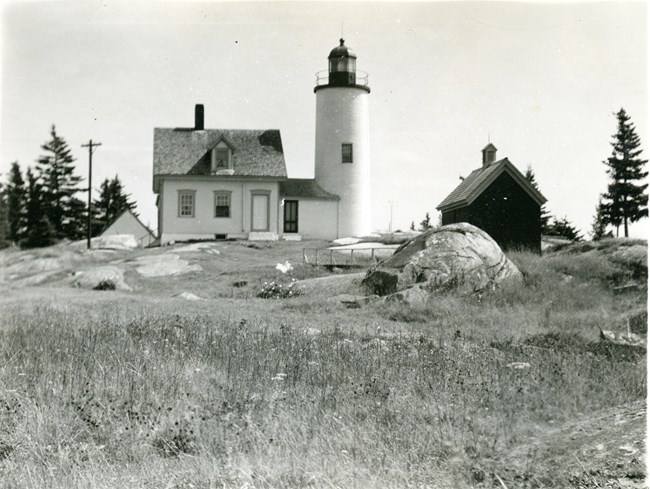|
Baker Island, one of the outermost Cranberry Isles, is located at the southwestern entrance to Frenchman Bay. Since 1967, Acadia National Park has owned a majority of this 162-acre island. The island preserves the history of a 19th-century homestead, the Baker Island Light Station, and the archeological relics of Maine’s maritime past. 
History of Baker IslandAround 1806, William and Hannah Gilley, along with their three children, moved from Norwood’s Cove on Mount Desert Island to Baker Island. The Gilley family, which eventually totaled 12 children, cleared Baker Island’s land for crops such as potatoes and corn, and raised oxen, cattle, and sheep, along with other farm animals. Virtually self-sufficient, the family sold butter and eggs in Southwest Harbor, as well as dried fish and common eider feathers in Boston, in order to purchase goods. Charles Eliot, a past Harvard University president and seasonal resident of Northeast Harbor, wrote an 1899 biography of John Gilley, the youngest son and tenth child. The biography, entitled, John Gilley - One of the Forgotten Millions, highlights Gilley’s hardworking, 19th-century coastal Maine life. Although many of William and Hannah’s children moved off Baker Island after coming of age, some remained on the island, and descendants of the Gilley family lived on Baker Island for 123 years.The Baker Island Light Station, the first keeper of which was William Gilley, was built in 1828. President John Quincy Adams ordered the building of the lighthouse because the shallow shoals of the Cranberry Isles created a shipping hazard. In 1855, a 13-meter high white brick lighthouse replaced the original wooden structure, and in 1966, the station’s light was automated. When the Coast Guard proposed discontinuing use of the lighthouse in 1991 and 1997, local mariners and residents successfully protested, and the lighthouse continues its active duty to the present day.With nine historically recorded shipwrecks on the island, Baker Island posed a great hazard to passing ships. In addition to its shallow shoals, at low tide, a rocky bar connects the island with Little Cranberry Island. Although no thorough archeological excavation has been conducted along Baker Island’s shallow waters, local residents have reported dragging up an old anchor, propellers, and a hauling block, among other historic artifacts. Significance of Baker IslandAside from Baker Island’s natural resources, such as evergreens, meadows, large, slab-shaped granite rocks, and land and seabirds, the island’s value lies in how it preserves many of Maine’s cultural resources. A cultural resource is any physical evidence or place of past human activity. Many of the historical structures of the Gilley family’s homestead are still standing on Baker Island, and as home to these structures, the island guards a tangible history of what nineteenth century farming and maritime life was like in Maine. The Baker Island Light Station, an active lighthouse that continues to warn mariners of the island’s hazardous shoals, was added to the National Register of Historic Places on March 14, 1988. It is one of the oldest lighthouses in the Mount Desert Island area. Furthermore, researchers have identified Baker Island as the most likely area in Mount Desert Island to yield maritime archeological material. With so many historically recorded shipwrecks on Baker Island, the island provides a wonderful opportunity for Maine to continue to uncover its coastal past.
Visit our keyboard shortcuts docs for details
For many years ending in 2024, a local company offered a five-hour boat cruise to Baker Island interpreted by an NPS park ranger. Since a short trip on a motorized launch was required to complete the journey, the NPS commissioned this video by Will Greene, a local filmmaker, as an equitable alternative experience for visitors with mobility impairments who could not participate in the full tour. This video now serves as an alternative for all visitors who aren't able to travel to the island on their own. More About Baker Island |
Last updated: July 16, 2025
